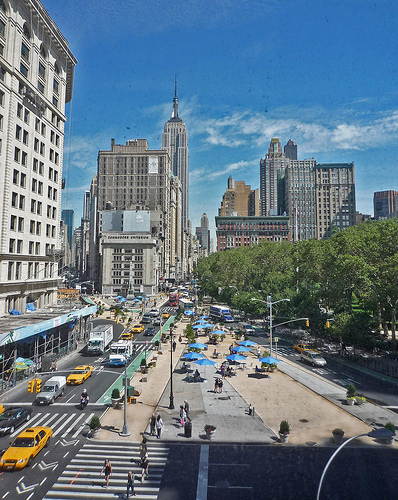
Which parts of Manhattan have seen the healthiest commercial real estate markets since the economic collapse of 2008? It's the Meatpacking District and the area around Broadway between Union and Herald Squares, according to a new report by broker Janet Liff [PDF], covered by Crain's last week. Notably, says Liff, both of those neighborhoods have received significant improvements to their streets, adding more public space and increasing safety for walking and biking.
In the Meatpacking District, Liff found, the availability rate of commercial space has dropped from its 2009 recession peak of 9 percent to just 3 percent, the lowest in the city. There's almost no office space to be found. In 2007 and 2008, the Department of Transportation installed Meat Market Plaza, the Gansevoort pedestrian plaza and the city's first protected bike lane on Ninth Avenue.
The story is similar, if less dramatic, in Midtown South, where new plazas have sprouted where Broadway meets other avenues. Rent is still cheaper than in the heart of Midtown, but since the recession, that gap has shrunk.
Of course, there are other factors at work, and we still don't have enough information to isolate the effect of livable streets on these neighborhoods' economic performance. Lower Broadway has been "Silicon Alley" for years and the city's tech scene is booming -- it's no surprise to see rents in the neighborhood increase. Liff's study looks at a handful of neighborhoods and doesn't use rigorous statistical techniques, so more research is needed to understand the relationship between bicycle and pedestrian improvements and the New York City real estate market.
But Liff's work shows once again that there's no reason to heed the sky-is-falling headlines when the city reshapes streets to enhance the pedestrian environment. Two years after the advent of its car-free plazas, for example, Times Square made its first-ever appearance on real estate firm Cushman and Wakefield's list of the ten most desirable retail locations on Earth.
Said one Broadway building manager Liff interviewed: "It’s the greatest thing to happen to New York City since the subway. The plazas attract people. Anything that attracts people is good for the area and good for business."





